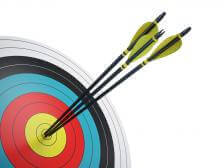Accuracy Versus Precision
Is there a difference between accuracy and precision? Is one more important than the other? When do the ideas of accuracy and precision show up in the real world? Keep on reading to find out!
Jason Marshall, PhD
Listen
Accuracy Versus Precision

But, as we’ll learn today, in the wonderful world of math, science, and engineering, they have very different meanings. And sometimes one is more important than the other. So, what are the differences? And when does each matter the most? Those are exactly the questions we’ll be answering today..
What Is Accuracy?
While the words “accuracy” and “precision” have pretty much the same meaning in everyday life, they mean quite different things in the world of numbers and measurements. In this world, the term accuracy is used to describe how close a set of measurements—be it your height, the brightness of a star, or anything else—are to their “true” value.
What do I mean by “true” value? In the case of your height, I mean the actual universally accurate value of your height that exists independent of all real world uncertainties, biases, and errors. Since this is an impossible idealization to realize, I really mean something like the average number that a bunch of height-measuring experts would come up with when using their best equipment and techniques to quantify your height.
To understand what all of this means, let’s imagine that you measure your height 10 times throughout the day and come up with numbers fairly evenly spaced between 5′ 7.5″ in the morning (when you’re barely awake and therefore super slouchy) and 5′ 8.5″ in the afternoon (when you’re bright-eyed and stout-statured).
Are these measurements accurate? Well, if your true height (as measured by our height measuring experts) is 5′ 8″, your measurements are indeed accurate since the average of your values is close to the true value. If, on the other hand, your true height is 6′ 2″, your measurements aren’t accurate at all.
What Is Precision?
The precision of a set of measurements tells you how closely the different values are to each other.
Here’s the weird thing: Although this set of measurements of your true 6′ 2″ height might not be accurate, it could nonetheless be precise. And that’s because the precision of a set of measurements tells you how closely the different values are to each other.
All of the height measurements you found ranged between 5′ 7.5″ and 5′ 8.5″, which is a range of only an inch. If all of your measurements ranged between 5′ 7.95″ and 5′ 8.05″, your measurements would have been super precise! And if they had ranged from 5′ 1″ to 6′ 3″, they clearly would have been much less precise.
The precision of a set of measurements also tells you something about how reproducible the measurement is. In other words, if you were to make another measurement, the precision tells you how likely it is that the new value will be close to the previous ones. If your measurements are precise, the new value is likely to be similar since the spread is small. If your measurements are not precise, there is a much broader range of values to fall within.
Precision Without Accuracy

In this example, the measurements of your height are precise but not accurate. To get a better idea of what this might look like in the real world, it’s useful to think about golf. Or for all of you Katniss Everdeen/Robin Hood fans, you can also think about archery. Here’s how it works:
Imagine you’re standing in the fairway hitting 10 practice shots onto the green. Or, if you prefer, imagine you’re honing your archery skills by shooting 10 arrows at a practice target. In either case, let’s say that each of your 10 shots all land closely together…far, far away from the intended target. Perhaps your golf shots all land within a few feet of each other but 40 feet from the pin. Or maybe your arrows all miss the target completely but pierce the bale of hay next to the target in a tight formation.
If you think about it, you’ll see that all of these shots are very precise, but also very innacurate. This situation is completely analogous to the one in which all of your height measurements are similar but nowhere near your actual height.
Accuracy Without Precision
So that’s how you can have precision without accuracy. But is it also possible to have accuracy without precision? Well, in our golf and archery examples, imagine that all of your shots have been nicely sprayed around the target, but not necessarily close to each another. Perhaps your shots form a ring some distance away from the target, or maybe they’re randomly distributed around the target.
Either way, the average position of your shot is very close to your target. In other words, your shots are quite accurate. But your shots aren’t exactly close to each other, which means they’re not at all precise. Similarly, if the average of the heights you measured is similar to your true height, your measurements are accurate. But if those heights are spread out all over the place, they aren’t precise.
Keep in mind that low precision doesn’t necessarily mean bad. Sometimes you don’t need high precision, sometimes you can’t get high precision, and sometimes things just don’t work out the way you hoped they would. But that doesn’t always mean that imprecise data is useless…it’s just not precise.
Bullseye: Accuracy and Precision
Occasionally though the stars align, the wind is at your back, and your measurements turn out to be both accurate and precise. What does that most glorious of glories look like? In our golf analogy, it looks like all of your shots landing within a few feet of the hole. In our archery analogy, it looks like all of your arrows bunched up on top of the bullseye. And in terms of the repeated measurements of your height, it looks like a list of measurements that are all similar to each other and also similar to the true value. When this happens, you have every reason to celebrate.
Wrap Up
Okay, that’s all the math we have time for today. But that’s not all there is to say about accuracy and precision. In fact, this topic and our recent discussion of rounding lead us nicely into a conversation about significant figures. So be sure to tune in next time to hear the exciting conclusion to this story!
opens in a new window
Remember to become a fan of the Math Dude on Facebook where you’ll find lots of great math posted throughout the week. If you’re on Twitter, please follow me there, too. Finally, please send your math questions my way via Facebook, Twitter, or email at mathdude@quickanddirtytips.com.
Until next time, this is Jason Marshall with The Math Dude’s Quick and Dirty Tips to Make Math Easier. Thanks for reading, math fans!
Betterment LLC is an SEC Registered Investment Advisor. Brokerage services are offered by Betterment Securities, an SEC registered broker-dealer and member FINRA/SIPC. Investments are not FDIC Insured. No Bank Guarantee. May Lose Value. Investing in securities involves risks, and there is always the potential of losing money when you invest in securities. Before investing, consider your investment objectives and Betterment’s charges and expenses. Not an offer, solicitation of an offer, or advice to buy or sell securities in jurisdictions where Betterment and Betterment Securities are not registered.
Target image from Shutterstock. and Hunger Games image courtesy of Featureflash/Shutterstock.

